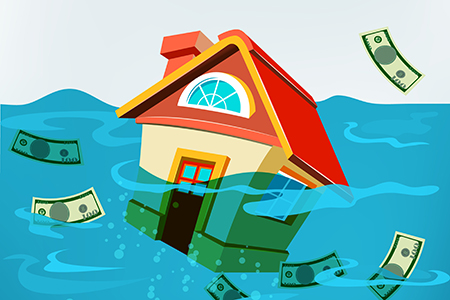Over 1 Million Properties Shed Underwater Status in 2016

Over 1 Million Properties Shed Underwater Status in 2016
A just-released report reveals underwater properties are steadily declining, with more than one million shifting status in 2016—a possible turning point in the ongoing inventory crisis.
According to ATTOM Data Solutions' Year-End 2016 U.S. Home Equity & Underwater Report, the amount of "seriously" underwater properties in the U.S. decreased by over one million last year, while the amount of "equity rich" properties increased by 1.3 million. Seriously underwater is defined as a property with a loan-to-value ratio 25 percent or more of its fair market value; equity rich is defined as a property with an LTV ratio 50 percent or less.
The opposing gap between the two is a signal of the overall health of the housing market, as well as the potential for short supply to, if marginally, improve.
"Since home prices bottomed out nationwide in the first quarter of 2012, the number of seriously underwater U.S. homeowners has decreased by about 7.1 million, an average decrease of about 1.4 million each year," says Daren Blomquist, senior vice president with ATTOM Data Solutions. "Meanwhile, the number of equity rich homeowners has increased by nearly 4.8 million over the past three years, a rate of about 1.6 million each year.
"Despite this upward trend over the past five years, the massive loss of home equity during the housing crisis forced many homeowners to stay in their homes longer before selling, effectively disrupting the historical domino effect of move-up buyers that feeds both demand for new homes and supply of inventory for first-time homebuyers," Blomquist says.
Approximately 10 percent—5.4 million—of all properties with a mortgage are still seriously underwater, according to the report, marking the lowest level since 2012.
The top five states with the most seriously underwater properties in 2016 were Nevada (19.5 percent share), Illinois (16.6 percent), Ohio (16.3 percent), Missouri (14.6. percent) and Louisiana (14.5 percent). The majority of the top five metropolitan areas with the most seriously underwater properties was located in Ohio: Cleveland (21.5 percent), Akron (20.1 percent), Dayton (20.0 percent) and Toledo (19.9 percent).
The top five states with the most equity rich properties in 2016, by comparison, were Hawaii (37.8 percent), Vermont (36.9 percent), California (36.0 percent), New York (34.9 percent) and Oregon (32.0 percent). The majority of the top five metropolitan areas with the most equity rich properties was located in California: San Jose (51.6 percent), San Francisco (47.7 percent) and Los Angeles (39.2 percent).
With this substantial reversal of trend, how long will the inventory shortage last? The drop-off dynamic of shrinking underwater properties and expanding equity could indicate the answer is sooner than expected.
Source: ATTOM Data Solutions
Reprinted with permission from RISMedia. ©2017. All rights reserved.
Mary B. Luca, MBA, ePro, Realtor
Licensed in DE & PA since 2007
Search for Real Estate on our Websites: www.TeamLuca.com and www.LucaTeam.com
Get Our Mobile Home Search APP: Text: LUCA to 87778
What's Your Home Worth: Get 3 Estimates Instantly
Area Market Trends: Instant Market Trends Report
Market Activity near your Property: ePropertyWatch
Facebook Like Our Page





